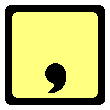 |
 |
PUNCTUATION |
|||||
|
|
|||||||
|
Commas
Commas are perhaps the most difficult punctuation device to use accurately. This is partly because to do so requires an understanding of English grammar, but also because their usage is sometimes a matter of preference or discretion.
Commas are used to separate items in a LIST.
This may be a list of nouns:
Remember to bring your shorts, running vest, trainers, towel and race number.
a list of adjectives:
Ernie has short, fat, hairy legs.
a list of verbs:
She was running, jumping, dancing and laughing for joy.
a list of statements:
I am going to have a bath, wash my hair, put on my best clothes and go out to a night club.
indeed, any kind of list.
The last item in a list is usually preceded by "and". This may be preceded by a comma (despite what you were taught at school), especially if it makes the meaning clearer.
Commas are used to set aside the NAMES of people being addressed.
Unfortunately, Mark, you still have to pay. Martin, have you finished that report? Shut up and listen to me, Michael!
Similarly, commas are used to set aside the TITLES (or other descriptors) of people being addressed.
I am sorry to call you out, doctor, but his temperature was very high. May I help you, sir?
Commas are used to mark off short ASIDES.
They look lovely together, don't you agree. In conclusion, may I thank everybody for their efforts. However, some things will have to change.
Commas are used to connect DIRECT SPEECH to its surrounding narrative. (See the section on SPEECH MARKS.)
Commas are used to mark off PHRASES IN APPOSITION. These are explanatory remarks added to a sentence and are enclosed by commas - in much the same way as brackets enclose additional information.
Leslie, my brother, used to be a jeweller. Mr Tomasi, who comes here often, likes to sit near the window.
Sometimes the phrase in apposition may come at the end of the sentence. In this case it is enclosed by a single comma (and the full stop at the end of the sentence).
Everybody loves my neighbour, Miss Marples.
It is not possible to have a phrase in apposition at the beginning of a sentence.
Commas are also used to mark off a number of other LONGER PHRASES.
These include participial phrases:
Looking over his shoulder, he darted into the doorway. Heaving a sigh of relief, she held the baby close. The driver, having signalled carefully, pulled out into the lane.
and adverbial clauses:
Although he was very tired, he watched the programme until it finished. Sue agreed, although she was quite tipsy, to have one more glass of wine.
and adjectival clauses:
Maria, the girl from reception, has agreed to go out with me. Her hair, which was golden ginger, blew wildly in the wind.
Although it helps to understand grammatical structures, it is not essential. If you read your work aloud and listen for the natural pauses, it is often possible to tell where the commas should be. If you mark these in pencil then read through your work again, pausing only where you have marked, you will soon realise whether any more (or any fewer) commas are required.
|
|||||||
|
Introduction - Capital letters - Full stops - Question Marks - Exclamation marks - Abbreviations - Contractions - Commas - Speech marks (Quotation marks - Inverted comas) - Possessive apostrophes - Colons - Semi-colons - Brackets - Hyphens - Dashes - Obliques (slashes)
|
|||||||
|
|
|||||||
